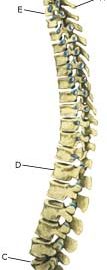|
||
|
||
|
Cause: The cause of scoliosis in children and adolescents is unknown in the majority of cases (idiopathic). Scoliosis is most commonly seen during the growing years, and is more often seen in girls than boys (Photo). Symptoms: Scoliosis does not necessarily cause pain or other symptoms. Treatment: Treatment is dependant upon the degree of severity. The majority of cases will normally be able to be controlled without treatment (article). It will normally be possible to take part in sports activities without any problems (article). Strength training and stretching of the stomach and back muscles is recommended. Supportive bandaging can be used if the scoliosis becomes worse (> 25-30 degrees) and the young person is still growing. It is normally possible to take part in sport at the usual level despite the bandaging (article). An operation may become necessary if the scoliosis becomes pronounced (> 40-50 degrees), and even earlier in some special cases. Certain forms of sport can be resumed 6-9 months after the operation (article). Complications: In some cases the presence of scoliosis can have other causes (infection, nerve disease, inborn bone change, rheumatic illness, bone disease, metabolic disorder). |


